Highlights for a Road Trip across Southern Spain
South of Spain roadtrip
If you are planning a roadtrip in the South of Spain we have prepared a very interesting itinerary that can be enjoyed from 10 days onwards.
The south of Spain is the most famous area of the country because of its unique and strong culture, a wonderful mix of Moorish, Gypsy and Christian traditions with no comparison anywhere in Europe. You have probably hear of Flamenco music. Welcome to the land of passionate dancers and multicultural heritage.
Our local destination experts have carried out in-depth research to compose road trip itineraries like this one. We aim at providing recommendations that offer overall great road trip experience, value and a fantastic selection of ideas collected with all the inside knowledge of our local experts.
The first thing we recommend when planning a road trip in the South of Spain is to set up certain priorities. The South of Spain is more than Andalusia (if we consider South all regions below Madrid Castilla la Mancha and Extremadura should also be added. We recommend you concentrate first on Andalusia if this is your first time in Spain.
Driving times in Andalusia
Andalusia is Spain´s largest region. Driving from Madrid south to Cadiz takes 6 hours. Cadiz is located as south as you can get. This gives you a first idea of driving times.
If we take the same approach from west to east (Huelva to Almeria) in Andalusia driving time would be over 4 hours and a half.
Driving from Cordoba to Seville takes 1,5 hours. Driving from Seville to Granada takes almost 3 hours. As with any road trip, the actual driving time will depend on how many stops you plan along the way.
Where to start your roadtrip?
Madrid is a perfect place to land. Then take the high speed train to Cordoba or Seville and rent a car there.
If you arrive from Madrid we believe the best option is to stop first in Cordoba. High speed train from Madrid to Cordoba takes less than 2 hours! You can hire a car in Cordoba though there are many interesting stops on the way from Madrid to Cordoba. If you start with a car in Madrid you may want to include Toledo, la Mancha (windmills and Almagro are good stops) , Jaen, Baeza and Ubeda before you reach Cordoba. You would need at least 2 days to cover all this though.
TOP RECOMMENDATION
One thing to bear in mind is that you may want to opt for a trip in which part goes on the road and some of the connections are made by train.
If you fly to Madrid we would recommend a train to Cordoba and then renting a car in Cordoba.
You may then return the car in Cordoba and get a train back to Madrid, or could also decide to drop the car in Granada, Seville or Malaga, all top cities in Andalusia and all of them with high-speed train connections to Madrid.
How to book your train at the best price?
The train network used to be a monopoly and the Spanish Rail Company (Renfe) was the only option. Other companies operate different routes today. We recommend you search for the best options using Omio since they compare the different providers
Let´s get with it!
Andalusia roadtrip
10 to 18 nights to get the most out of it (minimum recommended is 6 nights) Different options are presented in the itinerary we propose
End of March, April, May, June. We would prefer to avoid July and August. September and october are also excellent months. Late February and early November can also be good.
Our Favorite hotels to enjoy this roadtrip
CORDOBA - BLANCO DE CORDOBA
SEVILLE– CASA 1800
ARCOS DELA FRONTERA - PARADOR
Cordoba
Recommended time to stay: 1 or 2 days
During the Middle Ages, our first stop, Cordoba, was a powerful caliphate and the most advanced city in the world! Proof of this is found in its huge wonderful Mosque (ask for a night visit if possible), the Christian Kings Palace (Alcázar de los Reyes Cristianos), the amazing patios adorned with flowers (declared UNESCO World Heritage), the Cristo de los Faroles (best seen at dusk), the Roman Bridge, the Albolafia watermill, the Calahorra Tower, the Jewish Quarter and El Potro Square. Ten kilometers to the west you will find the ruins of Medina Azahara, an extraordinary former city-palace that once was as glamorous as the Alhambra.
Mezquita de Córdoba. Estimate 2 hours to visit. This is a unique monument and a must-see. You simply cannot visit Cordoba and don´t visit it! Tickets can be purchased at the entrance of the Mezquita-Catedral. The price of a ticket + the audio guide is less expensive per person than a guided tour. However we believe a guided tour makes more sense in this case. There are many guided tours with this one being our favorite one at a very reasonable price. It can be booked often with a discount and local guides are normally pretty good.
One very interesting option is to visit at dusk. We recommend this tour if you want to opt for a dusk visit
Top 3 tours to enjoy in Cordoba
We believe the best way to get the most out of a trip is to combine tours with local guides and time to explore and get lost by yourselves! These are the 3 tours we recommend in Cordoba. We recommend different webs from where tours can be booked, including a Spanish company that often offers better prices than other platforms.
CORDOBA COMPLETE TOUR
FREE TOUR OF CORDOBA
PRIVATE TOUR OF MOSQUE & CORDOBA
There are many other interesting tours in Cordoba, including wine tasting, excursions to Medina Azahara, bike tours, flamenco shows, tours to the amazing Patios in Cordoba, etc. We leave a link below with all tours
Cordoba attractions in-depth (besides the Mosque)
Cordobeses, the people from Cordoba, are very proud of their patios. The patios are actually a Unesco heritage site due not only to their beauty but also to the tradition and effort to preserve them from generation to generation. The white walls offer a fantastic background for the flowers that hang everywhere in the patio. The patios were built to make live easier for local cordobeses. A microclimate is created with the protection of the white walls, a fountain in the middle of the courtyard and the fresh air provided b y plants and flowers.
Despite they are at their best during the 2 first weeks in May (the 2 weeks in which they were traditionally opened to the public and a contest takes place to select the best patio) those 2 weeks are rather hectic and we recommend to visit at any time, even Christmas when they are decorated for the occasion.
Some patios are free of charge. IN this map you can find the patios that can be visited during the 1st 2 weeks of May. most of them are however not opened for public visits during the rest of the year. Another option is to book a guided tour with a local guide. They are inexpensive and very interesting. This patios tour is a good option and it includes a tapa and drink. The good thing about a tour like this is that you will stroll in the
Alcazar de los Reyes Católicos. Estimate 1,5 hours.
Tickets are bought at the entrance. Bear in mind that there is a special ticket with discount if you plan to visit 4 monuments in Cordoba (Museo Julio Romero de Torres -paintings- Alcazar, Museo taurino and baños árabes. The special ticket can be purchased at the tourist offices or at each of the museums. Money wise it makes sense if you visit at least 3 of the museums, otherwise it is better to pay the entrance ticket at each of them.
A good option for the Alcazar (10€ more expensive only than the tickets themselves) is a guided tour, either of the Alcazar itself or a more complete tour that includes more attractions and which can be a good option in case you are ready t join a 4 hour tour (the synagogue and the Cathedral-mosque are included besides the Alcazar) This tour, despite it is more expensive it ends up being very good value for money since it offers many things to see in one single tour. You can find here more details of this complete Cordoba tour with Mezquita, Alcazar and more.
- Cordoba´s Roman Bridge is beautiful by itself and provides an excellent perspective on the City specially at dusk when the lights of the mosque are on..
- Puerta de Almodovar. A fantastic example of arab architecture, this gate was one of the gates in the wall to access Cordoba.
- Enjoy and relax at the arab termal baths.
- Get lost in the jewish quarter. The best recommendation we can provide is to get to the Calle de las Flores (a street with its walls full of pots and flowers and which offers at its end views over the mosque. It may get a bit busy with tourists but still a must in Cordoba.
Restaurants we recommend to enjoy high quality local food
Cordoba is famous for the salmorejo (a dense and very tasty tomato soup) and flamenquines (ham and pork coated with egg and bread and deep-fried) and eggplant with honey. If we would only have 3 meals to enjoy in Cordoba we would select these 3 restaurants (please bear in mind that we recommend places where local food can be enjoyed)
Bodegas Campos. You will be able to enjoy a wine cellar atmosphere. Web
Sociedad de Plateros. A traditional tavern that dates back to 1868. Great local atmosphere. Web
Noor. If you are looking for a special menu for fine dining but that preserves a connection to local gastronomy this is a good (though expensive) option
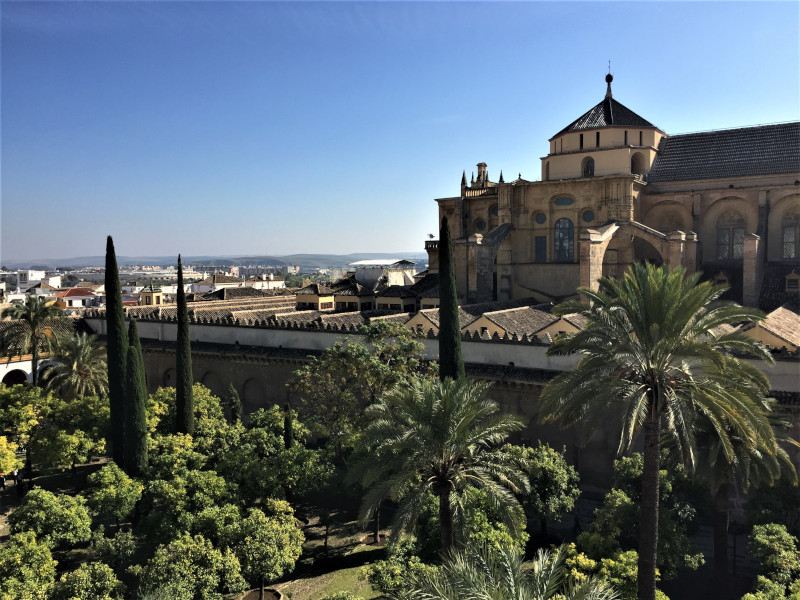
Medina Azahara was meant to be the new Capital for Abderraman III but it was destroyed at the end of the caliphate of Cordoba´s decline. What can be seen today is just a tenth of the original construction, which provides an idea of the magnificence of the construction. Located 8 kms west of Cordoba you should estimate 4 hours (for both getting there and enjoy the venue) Guided tours are also available. You can find one good option here.
Seville
Recommended time: 2 days
Seville is one of the most important cities in Spain and also the capital of Andalusia. The entire city center of Seville is a gem. The city’s Roman heritage can be found close by in Italica, and the Muslim one is evident all over the city. During the times of the Spanish Empire when trade and wealth was abundant, the city was given impressive architecture and a beautiful atmosphere.
Must do’s in Seville:
1) Visit the amazing Real Alcazar (used to film the scenes for the Water Gardens of Dorne during the 5th season of ‘Game of Thrones’);
2) Walk around the narrow and romantic Santa Cruz neighbourhood;
3) Visit the Cathedral (the largest one in Spain and the largest Gothic church in the world); climb to the top of the Giralda bell tower (originally built as a minaret during the Moorish period)
The following tour is probably the best option to enjoy the Alcazar and the Cathedral plus Giralda. It offers skip the line, tickets and excellent value for money. If you plan to enjoy just one tour in Seville it makes sense to opt for this one.
4) Take a ride around the Cathedral on a horse-drawn carriage while drinking a “vino de naranja” (orange wine). We recommend you to be careful with prices of this service. Despite the situation has improved a lot in recent years it is still possible to find cases in which the drivers try to charge much more than what the actual price should be (the service and its prices are regulated by the Seville tourism agency)
5) Visit the famous Plaza de España and Parque de Maria Luisa (Plaza de España was used to film scenes in Lawrence of Arabia and Star Wars);
6) Enjoy a Guadalquivir river cruise and walk along the riverbanks from the Torre del Oro to the Maestranza bullring.
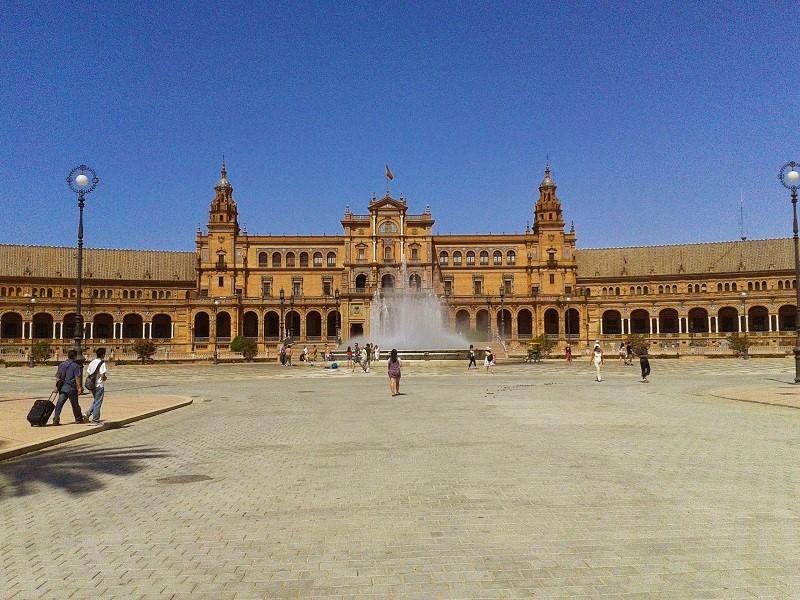
More places to visit in Seville are Metropol Parasol, the Reales Atarazanas, the Fábrica de Tabacos, the Monument to Cristopher Columbus, the Casa de Pilatos, the Maestranza Theatre, the Saint Telmo Palace, the Archivo de las Indias, the Lonja, the Palacio Arzobispal, the City Hall, the Dueñas Palace, the Plaza del Salvador, the Don Fadrique Tower, the city walls, the Plaza Nueva, the Macarena Basilica, the Contemporary Art Museum, the Fine Art Museum, the Alameda de Hércules, and the Barrio de Triana. The main city feasts are Holy Week and Easter and the famous ‘Feria de Abril’.
Granada
Recommended time: 2 days
Granada is the city of the Alhambra palace, the most visited monument in all of Spain. By the way, in Spanish, Granada means pomegranate, a fruit that is represented on the city coat of arms and even on the bottom of the Spanish one. The Alhambra is both a palace and a fortress located on top of a hill not very far from the highest peaks of the Iberian Peninsula. Due to this, one of the most typical images of the palace has the white background of the Sierra Nevada Range. Do not miss the Generalife gardens and remember that you have to buy your tickets in advance.
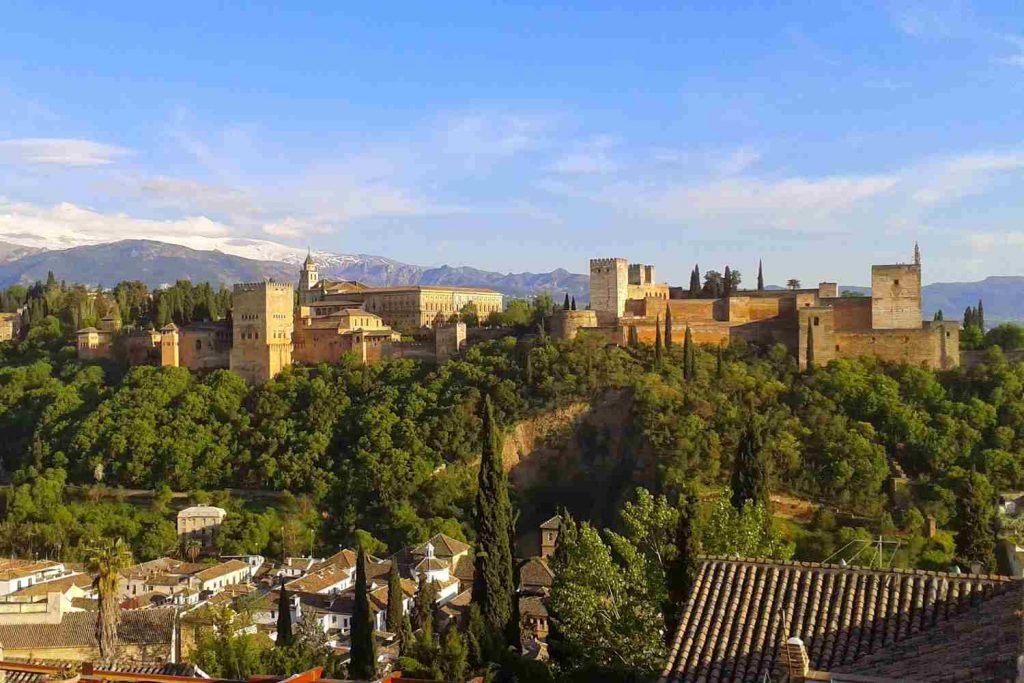
After visiting the Alhambra, you can go to the cathedral and the royal chapel, where the Catholic Kings were buried. You can also visit the Bañuelo, some of the most well preserved ancient Arab baths in Spain. Do not miss exploring the Albaycin district and its famous lookout called San Nicolas. The other well-known district is Sacromonte, famous for its gypsy caves and their flamenco shows.

Options if you have 10 days for your trip in Southern Spain
In case you have 10 days we would recommend to add 1 of this stops to the 3 main attractions (Cordoba, Seville and Granada) mentioned above)
Malaga
Malaga has made big efforts to modify its appearance which has produced good results in the last decade. A nice harbor welcomes you from where you can easily walk through the Park of Alameda and reach the attractive city center. Most of it has been pedestrianised. Here, strolling around Larios St and Plaza de la Merced, you will find the spectacular cathedral, Picasso’s birth home, the amazing Roman theater and the Alcazaba fortress. On top of the same hill as the Alcazaba, you can see the powerful castle of Gibralfaro.
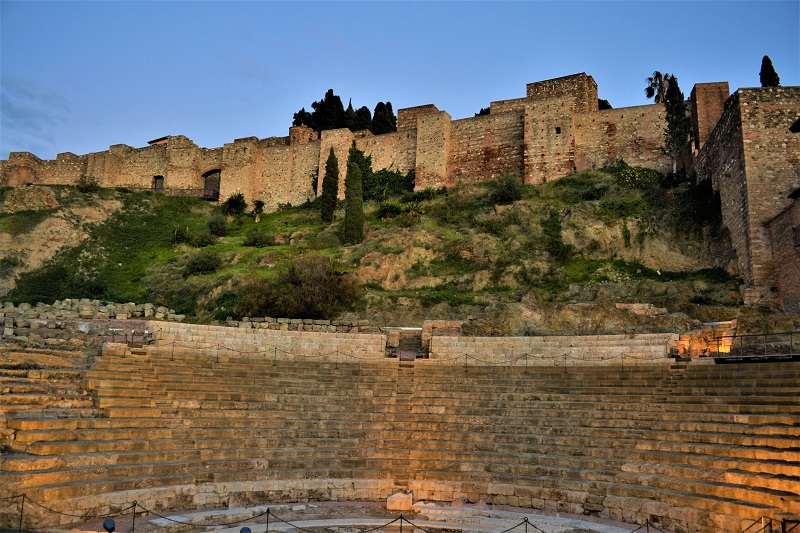
Cadiz (+ Jerez de la Frontera + El Puerto de Santa Maria)
The city of Cadiz rests on a long and narrow isthmus and has had a long seafaring tradition since its beginning. In fact, for the Phoenicians, Greeks, Romans and Arabs, Cadiz was an important strategic harbor.
Cadiz, nicknames “the silver cup”, is a lively and history city with remarkable monuments such as the Cathedral, the city walls, the Church of Santa Cruz, and the Genovese Park. Cadiz is also famous for organizing one of the most important Carnival festivities in all of Spain.
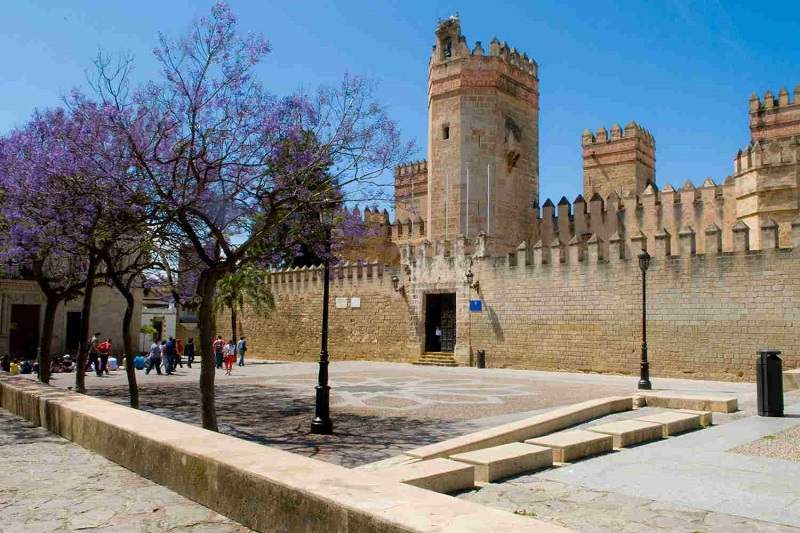
Charming towns and villages in Southern Spain
In this next part, we cover some of the most interesting villages and small towns in southern Spain.
Highlight number 6 – The other three capitals (Huelva, Jaén and Almería)
Huelva
Huelva is located in the southwest corner of Spain just 50 kilometers from the border with Portugal. The city is linked with Christopher Columbus’ departure which took place at the port of Palos (near La Rabida Monastery). Like many Spanish cities, Huelva has a cathedral and many churches such as La Concepción and Saint Peter’s. Other remarkable monuments are the Monument to Columbus, the Angustias Convent, the Sanctuary of Nuestra Señora de la Cinta, the Grand Theater and the Reina Victoria district, a bizarre example of British suburbs due to the times in which British companies were extracting minerals nearby during 18th and 19th centuries. Don’t miss a visit to the mineral loading platform.
Jaen
On one hand Jaen is the smallest capital of all the Andalusian provinces, but on the other hand, Jaen is the world capital of olive oil. The city is located in the hills and at the foot of the impressive mountain on which the Castle of Santa Catalina was built (currently works as a luxury hotel). From the viewing point of the castle, you will be able to see a never-ending land of olive trees. The center of the city spreads out around the wonderful cathedral, a gem of the Spanish Renaissance. The Arab baths, which are located in the basement of the Palace of Villardompardo, are some of the largest you can visit in Spain. A few other highlights to visit are the Church of Magdalena and the Jewish Quarter.
Almeria
The neighborhood of La Chanca has the most local feel and surrounds the San Cristobal hill on which lies the amazing Moorish castle of Alzazaba. From here, you can get a gorgeous panoramic view of the city. The Cathedral of Encarnacion (XVI Century) was also designed as a fortress to repel the attacks by the Algerian pirates. Furthermore you can stroll around the district of Muelle de San Pedro, the Malecon Gardens, the nice Plaza Vieja or the Virgen del Mar square. This square is definitely a great place for having some tapas, although this also applies to rest of the city.
Not far (30km) you will be able to reach the Tabernas desert, famous around the world because of the Westerns that have been film there.
Highlight number 7 – Best Villages in West Andalusia (provinces of Huelva, Seville, Cordoba and Cadiz)
Alájar (province of Huelva)
This beautiful white village is located in the middle of the Sierra de Aracena y Picos de Aroche Natural Park. This is a green area near the Portuguese border where the famous Iberian pigs are raised in free-range.
Cortegana (province of Huelva)
This village also belongs to the Sierra de Aracena y Picos de Aroche Natural Park. It looks like a white stain that is floating over the wavy green hills that are filled with cork, oak and chesnut trees. The views from its wonderful castle are superb!
Sanlúcar de Guadiana (province of Huelva)
There is a river called Guadiana that runs between Spain and Portugal. On each side of the river, you will find the white villages of Sanlúcar de Guadiana, belonging to Spain, and Alcoutim on the side of Portugal. The water reflects the white of the houses and the dark edges of the hills. It’s even nicer at dusk when the villages are lit up.
Arcos de la Frontera (province of Cádiz)
Arcos de la Frontera, meaning “arches of the border” in English, gained its name due to the border that separated the Christians from the Moors during a 13th century battle. Located on a high rock, the village boasts of stunning views, a magnificent castle, two beautiful churches and lots of narrow winding streets and romantic squares.
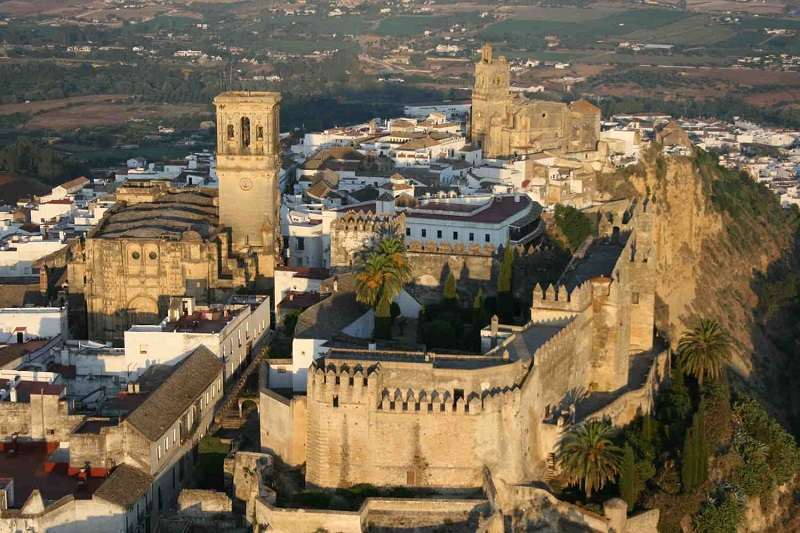
Grazalema (province of Cádiz)
Grazalema is the highest village in the province of Cadiz due to its location in the middle of the Sierra de Grazalema Natural Park. It is surprising to see how green the area is being that the village is deep within the south of Spain. Maybe this is why Grazalema is considered one of the most beautiful villages in the entire province of Cadiz, with its white houses surrounded by a wild and green environment.
Olvera (province of Cádiz)
The white village of Olvera was built around a rock on which stands its Moorish fortress from the 12th century. Not very far from the fortress, after a short walk along the narrow and winding streets, you will find the Church of Nuestra Señora de la Encarnación.
Setenil de las Bodegas (province of Cádiz)
This is an unexpected unique village among the white villages of Andalusia. It is famous for the homes that have been built into the massive rock that overhangs above the Quadalporcun river. The row of white facades under the enormous heavy rock is quite the site to see.
Véjer de la Frontera (province of Cádiz)
There is no doubt that this is one of the most beautiful villages in Spain. It is located on top of a hill seven kilometers away from the famous Cape Trafalgar. The white winding and narrow streets run downhill from the castle from which you can enjoy magnificent views.

Zahara de la Sierra (province of Cádiz)
The name of the village has two different parts: Zahara (from the Arabic ‘orange blossom’) and ‘de la Sierra’ (from the Spanish ‘of the mountain range’). Now just imagine a green and rocky mountain with a little Moorish castle on top, the white houses following the road that comes downhill from the castle, and a very deep turquoise reservoir at the bottom part of the valley. This village belongs to the Natural Park of the Sierra de Grazalema.
Carmona (province of Seville)
On your way from Córdoba to Seville (or vice versa), you most definitely need to make a stop in Carmona. It is one of the most important cultural sites within the whole region. The impressive Roman walls, the Roman Necropolis, the Alcázares (Moorish palaces), the Church of Santa Maria, the Church of San Felipe, the Puerta de Cordoba, and the Puerta de Sevilla are some of the best examples of the amazing architecture in Andalusia.
Écija (province of Seville)
Another important stop between Cordoba and Seville is the town of Ecija. This was a Roman city which later became Visigoth, Moorish and finally Christian when it was reconquered by the Castilian king Ferdinand III in 1240. Due to its rich history, Ecija has plenty of monuments of interest such as the Palaces of Benameji, Peñaflor, Valdehermoso, Palma and Santaella and the Churches of Santiago, Concepcion, Santa Cruz, Los Descalzos, San Juan and Santa Maria.
Lebrija (province of Seville)
Lebrija is the capital of Las Marismas, the first place outside of the Americas where corn was planted and grown successfully. It is located in the lower basin of the Guadalquivir River where it creates a fertile flat surface with plenty of sun and water. You can see this wealth in Lebrija in its white manor houses with coats of arms and iron-forged balconies, a castle on the highest point, the Hospital de Misericordia, the Cilla del Cabildo (know the Culture Center), the Church of Santa Maria la Mayor, and the Convent of los Concepcionistas.
Marchena (province of Seville)
This village is called “The Unknown Beauty” because of its urban structure within the walls with the famous Puerta de Sevilla, the churches of Santiago, Santa Maria de la Mota and San Juan, the Convent of San Agustin, and the white and yellow Casa-Palacio de Nicolas Diez (XVIII century).
Osuna (province of Sevilla)
Ecija, Marchena and Osuna form a triangle (no more than 40km from each other). Osuna was the residence of the Duke of Osuna which explains why the city has an impressive list of outstanding monuments. The bullring has become world famous because of the TV show ‘Game of Thrones’. In addition to that, you will have a great time while visiting the university, the Convent of La Encarnacion and its spectacular patio, the Palace of los Cepeda, the Colegiata de Santa Maria de la Asuncion, and the Palace of Marques de Gomera.
Almodóvar del Río (province of Córdoba)
The white village of Almodovar del Rio might not be a very famous one but its amazing Moorish castle appears in pictures, paintings, movies or TV shows every now and then. Its castle represents Highgarden in “Game of Thrones” and sits on the banks of Guadalquivir river. The views are cool because the village belongs to the Natural Park of Sierra de Hornachuelos, which is surrounded by a lot of cork, olive, and pine trees.
Iznájar (province of Córdoba)
This white rural village spreads out from the top of the mountain where the castle and church are located and continues downhill. It is confined by a large and long cliff that faces the Genil river reservoir. There is no doubt that you will enjoy superb views of this reservoir and Sub-Betica Range from this beautiful village.
Priego de Córdoba (province of Córdoba)
Not many people know about Priego de Córdoba because it is not located in between two important cities or next to a highway, but this village is considered one of the most beautiful in Spain. The village belongs to the Sierra Subbetica Natural Park that is located to the west. The noble and white village of Priego de Cordoba has plenty of charming corners, narrow and irregular streets, noble houses, and important monuments such as El Rey and La Salud Fountains, the remains of the castle, the churches of Las Angustias and Saint Peter, and the convents of Saint Francis and Saint John.

Zuheros (province of Córdoba)
The village faces the Sierra Subbetica Natural Park to the south and it is a nice example of a typical white Andalusian village: many narrow streets growing and spreading downhill from the top upon which stands a very beautiful small castle rock. Just 4 kilometers from Zuheros, there is one of the most important neolitic remains in Europe: the Bat’s Cave (Cueva de los Murciélagos).
Highlight number 8 – Best Villages in East Andalusia (provinces of Málaga, Granada, Jaén and Almería)
Antequera (province of Málaga)
Antequera and its surrounding area have been inhabited since the Bronze Age by the native Iberians. You can vist different “tholos” and “dolmens” such as Romeral, Viera and Menga. Later on Romans, Barbarians, Moors and Chistians played their own role in the local history. Another must is El Torcal, a UNESCO World Heritage site just 16 kilometers away. The village of Antequera is almost fully white with many brown spots: these are the spires of the churches and the walls and towers of the superb Moorish fortress that controls the city from the top of the hill.
Casares (province of Málaga)
Casares, a very well-known location between the Ronda Mountain Range and the famous Costa del Sol, was declared a village of historical and artistic importance and is unmistakeably one of the most beautiful white villages in Andalusia (and in Spain). It is situated on top of a hill and, wherever you walk around the village, the views of the village itself and its castle ruins are amazing. There is a legend that says Julius Caesar was cured after bathing in La Hedionda Baths and founded Casares as a sign of gratitude. Despite this, the town looks very Moorish with its compact design, crammed with narrow streets and the castle ruins. The area offers good opportunities for lovers of trekking, rafting or potholing.
Frigiliana (province of Málaga)
If you love slopes and stairs, white Andalusian houses and romantic corners, Frigiliana is your place. It is perfect for breaking your routine when you are on the beach near Nerja because it is only a 6 kilometer drive uphill, although very uphill. Now you can imagine the spot: wonderful sea views! Do not miss the former Count of Frigiliana’s Palace (currently the sugar cane mill) and Las Hoces del Higueron.
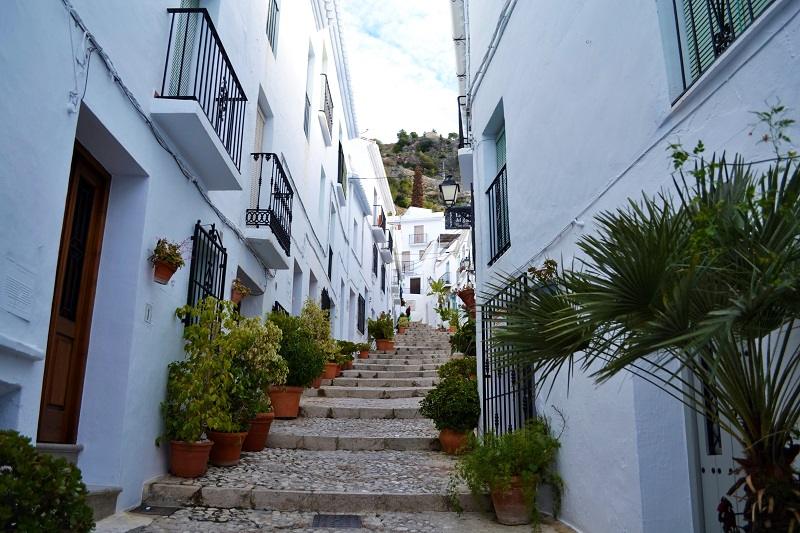
Júzcar (province of Málaga)
It is not easy to get to Juzcar like many other villages in the Serrania de Ronda mountan range. So, what makes small village so special? It´s blue! Welcome to the very unique blue little village of Andalusia. There is a good reason for this. Juzcar was chosen for filming a movie: the Smurfs 3D! Now everything makes more sense. It is a pity that this village lost the rights of using Smurfs image and merchandising in 2017 but the blue color remains.
Mijas (province of Málaga)
Is this a nice Arabic-style white village on the very top of a mountain or a wonderful balcony that is facing the Mediterranean Sea? It is both! Due to the slopes and the narrowness of the streets, traditionally, donkeys were used for delivering goods. They are still used today but for touristic purposes. The most important buildings are the Sanctuary of the Virgen de la Peña, the Inmcaculada Concepción Church, and the Bullring.
Nerja (province of Málaga)
Nerja is the most important city on the east side of the Costa del Sol and very well known for the quality and beauty of its beaches. Facing north, you can see fertile orchards with a nice mountainous background. Facing the other three cardinal points, you can see the coastline or the sea. Because of this, the “Balcony of Europe” was built, from which there are phenomenal panoramic views. The El Salvador Church is another building of interest but the most remarkable locations have been provided by nature: the spectacular Nerja’s Cave and the Maro-Cerro Gordo’s Cliffs.
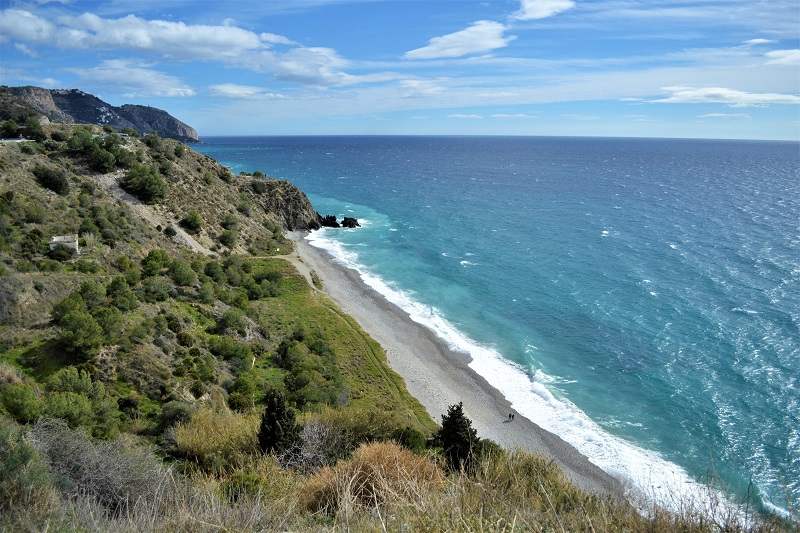
Ronda (province of Málaga)
The insurmountable obstacle of El Tajo Gorge was splitting the city of Ronda in two different parts (the old and the new town) until the Puente Nuevo (New Bridge) was built in the late 1700s. There is a formidable view from the top of the bridge towards the Serrania de Ronda (Ronda’s Mountain Range) and to the bottom part of the gorge where the Guadalevin River runs downhill (about a 100m gap). Ronda is also the birthplace of modern bullfighting, when in the 18th century, the matador Pedro Romero decided to fight the bull on foot instead of while riding a horse as was common until that moment. The famous bullring is currently a museum. On the other side of the bridge, where the old own is located, you can visit most of the highlights of Ronda. These include the Casa de Don Bosco, the Moorish King’s House, the Wine Museum, the Mondragon Palace and the main square whose name is a tribute to the Duchess of Parcent.
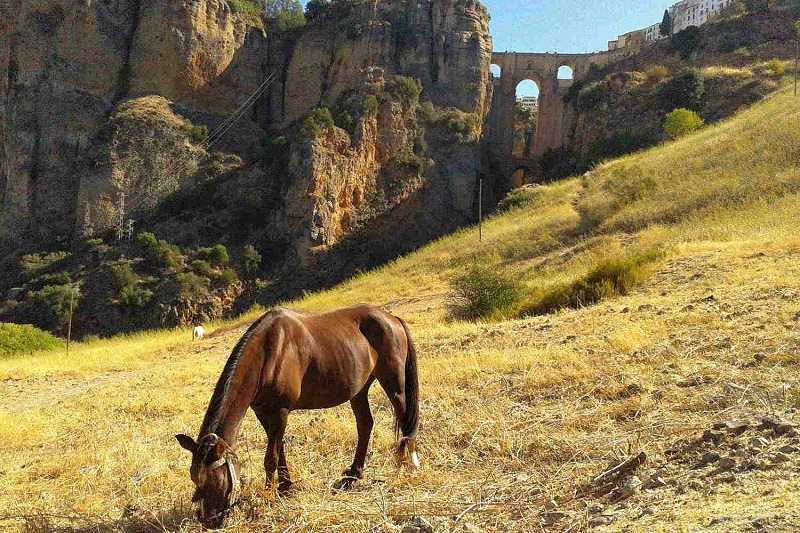
Capileira (province of Granada)
This is the highest of the three famous villages that are located along the left bank of the Poqueira River’s ravine. Capileira, whose name comes from the Latin word ‘capitellum’ meaning summit, has the charm of the villages within the Alpujarras region: narrow and sloping streets, whitewashed facades, many little balconies, and a large representation of different potted plants.
Guadix (province of Granada)
Guadix is one of the oldest human settlements on the Iberian Peninsula. The Ermitas and Cuevas districts have witnessed time pass by since the troglodytes lived around the area. Out of all of the caves, there are two you should visit, the Padre Poveda’s and the Cave-Museum of Art and Traditions. If you like panoramic viewpoints, you can head to La Magdalena and to the Alcazaba (Arab fortress). Finally, do not miss the Cathedral or some churches such as Santa Ana, San Francisco or Santo Domingo.
Montefrío (province of Granada)
Montefrio means ‘cold mountain’ but by no means will you feel cold while looking at it from the outside or from the top of the Peña de los Gitanos. This is more a cliff than a rock which dominates the whole village along its bottom part. There is a spectacular view from the Arab fortress and the Church that looks to the void. In addition to this, the area is crammed with a wonderful megalithic complex formed by lots of dolmens.
Pampaneira (province of Granada)
This is the lowest of the three famous villages that are located along the left bank of the Poqueira River’s ravine. Take into account that not so far from here, are the first and third highest peaks of the Iberian Peninsula (Mulhacen and Veleta). The three villages are Capileira, Bubion and Pampaneira, the most well-known villages within the Alpujarra region which goes from the southern face of Sierra Nevada National Park to the northern side of the much smaller mountain range that is facing the Mediterranean Sea. The landscape looks like the Himalayas, arid, rocky and sloping. Perhaps, this was the reason it was chosen by the Buddhist community to settle here at the Monastery of O Sel Ling.
Baeza (province of Jaén)
This is certainly a noble village and a perfect place to stroll around if you like architecture. You will be shocked by the wonderful Plaza del Pópulo (or Lions Square) and by Santa Maria Square and the Cathedral, or by the Old University of Baeza, the City Hall, the Palace of Jabalquinto and many others.
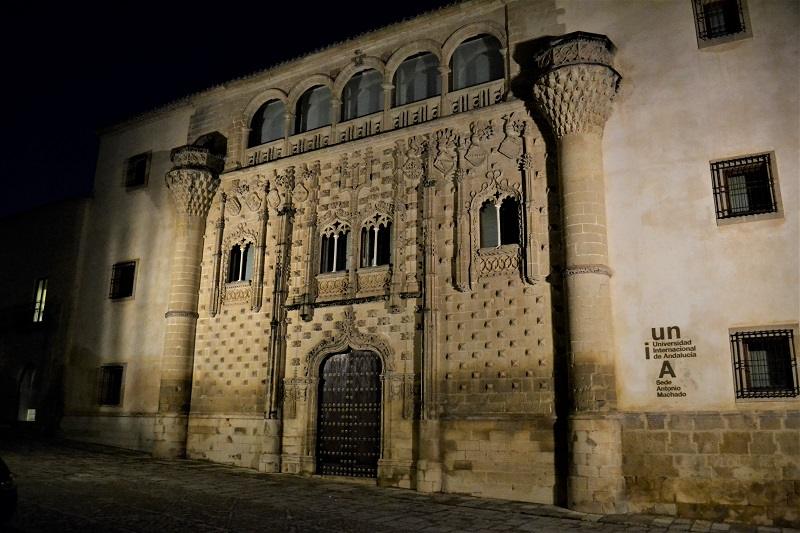
Cazorla (province of Jaén)
This village is located within the ‘Sierras de Cazorla, Segura and Las Villas National Park’, a remarkable green area in the southeast of Spain. In fact, the Guadalquivir River (the main river in Andalusia that passes through Seville), begins from this park. The village has a stunning presence due to the fortress (La Yedra Castle) that lies on the highest rocks and rules above the white houses with the permission of the surrounding mountain range and the watch tower that is on its top (the Five Corners Castle).
La Iruela (province of Jaén)
Did you enjoy the TV series ‘Game of Thrones?’ If so, you have to see the village of La Iruela, from above (within the castle) and from below this small village looks spectacular. As many of the fortresses in Spain, the castle and the Monastery of the Templars are currently ruins but…what amazing ruins they are!
Úbeda (province of Jaén)
Ubeda is a monumental city that will surprise you. As a first approach, you can stroll along the walls, stop by the pottery museum (called Paco Tito’s) and later enter the city through Granada’s Gate and head to the main square. From this point, it could be logical to make a loop around, discovering the city itself and visiting the Andalusian Art or the Olive Oil Museums. Several of the gorgeous religious buildings you can visit are the Basilica of Santa Maria de los Reales Alcazares, the Water Sinagogue and El Salvador Sacred Chapel. Also, there are those that were not designed for religious purposes such as the Marquis of Mancera’s Palace and the Vela de los Cobos’ Palace.
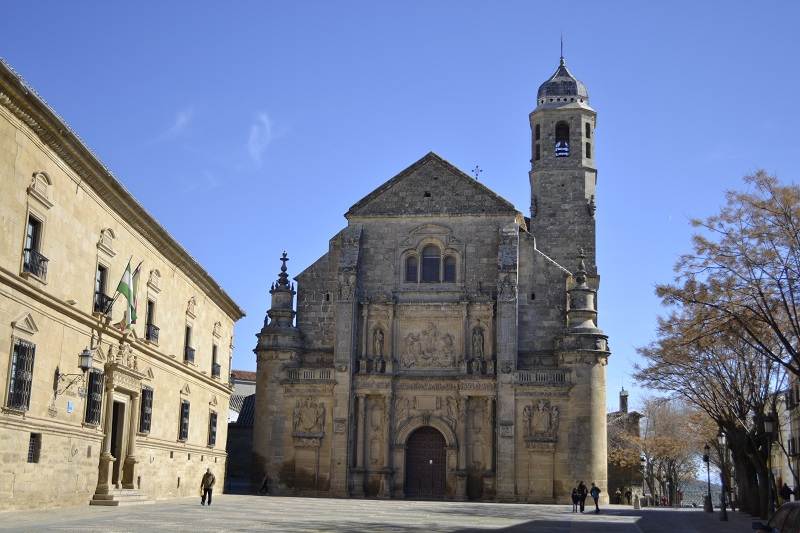
Mojácar (province of Almería)
Heading uphill, not very far from its wonderful beaches, you will find the beautiful white village of Mojacar. Did we say white? For certain it is white, but there are flowers and plants covering facades, lanes and corners…and also, many doors are blue.
Níjar (province of Almería)
Nijar belongs to Cabo de Gata-Nijar Natural Park which shows the most Maghreb-looking landscapes in Western Europe. And speaking of Westerns, Nijar is only 20 kilometers southeast from Tabernas Desert, a famous location for filming lots of western films. The sloping village is known for its craftwork and because of the beauty of its isolated beaches 25 kilometers away.
Vélez-Blanco (province of Almería)
The province of Almeria’s symbol is very well known all over Spain. It is the Indalo, a very simple Neolithic painting of a man with a bow that joins his extended arms over his head. This painting and many others were located in Velez-Blanco’s surroundings, an area that has plenty of caves. The most famous is Letreros Cave, where the Indalo was found. The Moorish-style village has a Renaissance-style castle on the top of a boulder.
If you only have 7 days or less available we believe it makes more sense to do a triangle with Seville, Cordoba and Granada and dedicate1 or 2 days to each city, maybe 3 in Seville. Bear in mind that all 3 are now connected by fast speed train, which makes transfers really comfortable. Malaga has an airport with great connections and you will also be able to return to Madrid by plane (from Malaga or Seville) or by train (from Granada, Cordoba or Seville)
is proudly powered by WordPress
